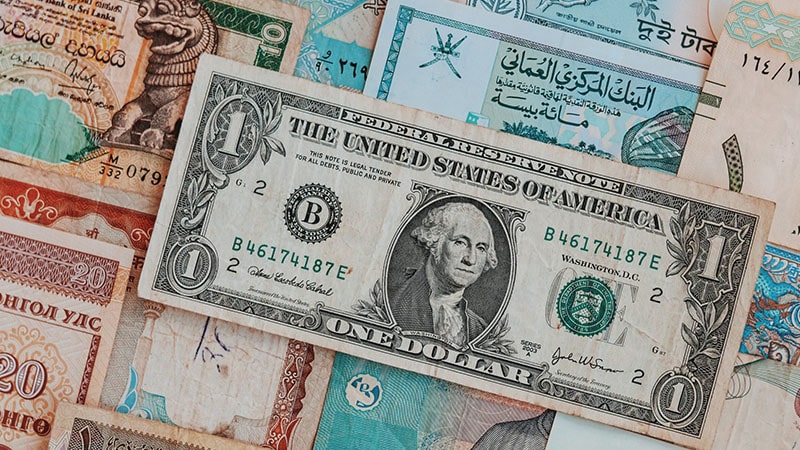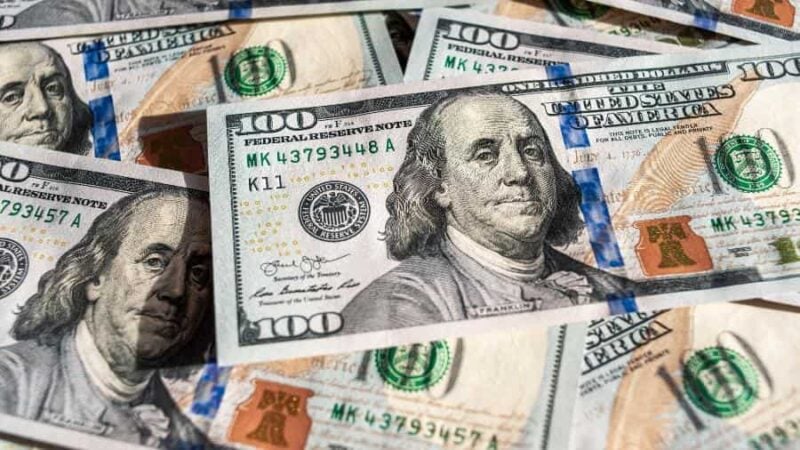What is the US Dollar Index (USDX)?
The US Dollar Index (USDX) serves as an indicator of the value of the US dollar compared to a selection of international currencies. This index was established by the United States Federal Reserve in 1973, after the end of the Bretton Woods Agreement, and is currently managed by ICE Data Indices, which is a branch of the Intercontinental Exchange (ICE).
The USDX set comprises six currencies, seen as the United States' most significant trading partners. However, the index only underwent one update, which took place in 1999, when the euro replaced several European currencies such as the German mark and the French franc, among others. Therefore, it no longer accurately reflects the reality of United States foreign trade.
How does the US Dollar Index (USDX) work?
The USDX calculation is based on the exchange rates of six currencies: the euro (EUR), the Japanese yen (JPY), the Canadian dollar (CAD), the British pound (GBP), the Swedish krona (SEK) and the franc Swiss (CHF). The euro represents the largest share of the index, with 57,6%, followed by JPY (13,6%), GBP (11,9%), CAD (9,1%), SEK (4,2%) and CHF (3,6%). The index began in 1973 with a base value of 100, and subsequent values are measured against this initial base.
The launch of the index occurred shortly after the dissolution of the Bretton Woods Agreement, a period in which participating countries settled their balances in US dollars, which were then the main reserve currency and convertible to gold at a fixed rate. With the temporary suspension of the gold standard by President Richard Nixon, in response to the overvaluation of the dollar, countries were free to adopt floating exchange rate regimes from 1973 onwards.
History of the US Dollar Index (USDX)
Throughout its history, the US Dollar Index has experienced significant fluctuations. It reached an all-time high near 165 in 1984 and a low of around 70 in 2007. In recent years, the index has ranged between 90 and 110, influenced by macroeconomic factors that include inflation or deflation of the dollar and the currencies that make up the index, in addition to periods of recession and economic expansion in these countries.
Since its inception, the index's basket of currencies has been changed only once, with the addition of the euro in 1999, replacing several European currencies that were previously part of the index. In the future, it is expected that new currencies, such as the Chinese yuan (CNY) and the Mexican peso (MXN), may be incorporated into the index, reflecting the growing commercial importance of these countries to the United States.
Interpreting the USDX
An index value of 120 indicates that the US dollar has appreciated by 20% against the basket of currencies during the period in question. In simple terms, an increase in the USDX indicates that the US dollar is strengthening or gaining value compared to other currencies. Likewise, an index of 80, reducing by 20 in relation to the initial value, suggests a devaluation of 20%. The results of appreciation or devaluation vary according to the period of time analyzed.
How to trade USDX
The US dollar index allows traders to monitor the appreciation of the dollar against a specific basket of currencies in a single transaction, also enabling the protection of investments against dollar-related risks. Futures or options strategies can be applied to USDX, and these financial products are currently traded on the New York Stock Exchange. Investors can use the index to hedge against currency movements or speculate on its value. Additionally, USDX is available indirectly through ETFs or mutual funds, such as the Invesco DB US Dollar Index Bullish Fund (UUP) and the Wisdom Tree Bloomberg US Dollar Bullish Fund (USDU), which track or speculate on changes in the value of the American dollar.
Invesco DB also offers the US Dollar Index Bearish Fund (UDN), which operates by shorting the dollar, profiting from currency devaluation.
Conclusion
The US Dollar Index (USDX) is a crucial tool for understanding the position and performance of the US dollar relative to other major global currencies. Its carefully weighted composition and precise calculation offer a comprehensive view of the dollar's strength or weakness relative to a diverse basket of foreign currencies. Investors, traders and economists use the USDX as a fundamental indicator to evaluate currency trends, make investment decisions and understand global economic impacts. By understanding the meaning and methodology behind USDX, market participants can make more informed decisions and better manage risks in an increasingly interconnected and dynamic financial environment.
FAQ
What does USDX tell you?
The Dollar Index reflects the relative value of the US dollar compared to a basket of significant global currencies. When the index increases, it indicates that the dollar is appreciating in relation to this basket, and vice versa.
What is the composition of the USDX Basket?
USDX monitors the relative strength of the dollar (USD) against a basket of foreign currencies. The weights have been established since 1973 (with adjustments in 2002 when the euro replaced several European currencies):
- Euro (EUR) – weight of 57,6%
- Japanese Yen (JPY) – 13,6%
- British Pound Sterling (GBP) – 11,9%
- Canadian dollar (CAD) – 9,1%
- Swedish krona (SEK) – 4,2%
- Swiss franc (CHF) – 3,6%
How is the USDX Index calculated?
USDX is calculated based on a basket of six currencies, each with different weightings (as listed above). The index calculation is a weighted average of the exchange rates of the US dollar against these currencies, normalized by an indexing factor (which is approximately 50,1435).
USDX = 50,14348112 × EURUSD^-0,576 × USDJPY^0,136 × GBPUSD^-0,119 × USDCAD^0,091 × USDSEK^0,042 × USDCHF^0,036







